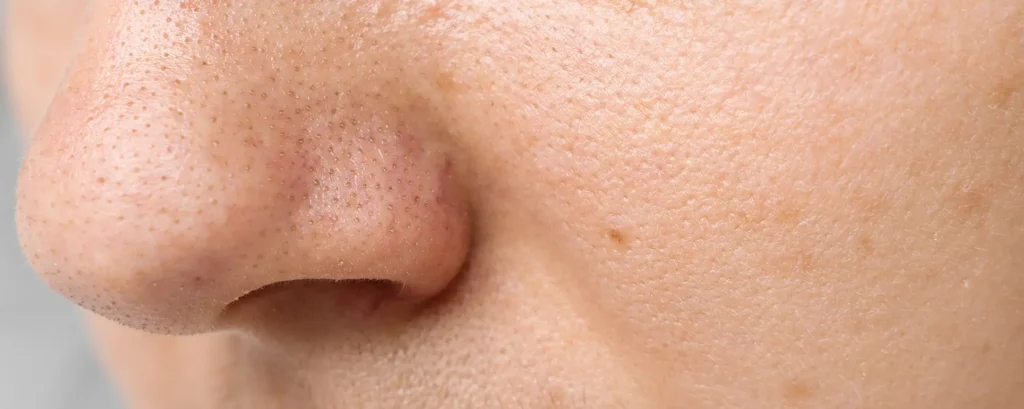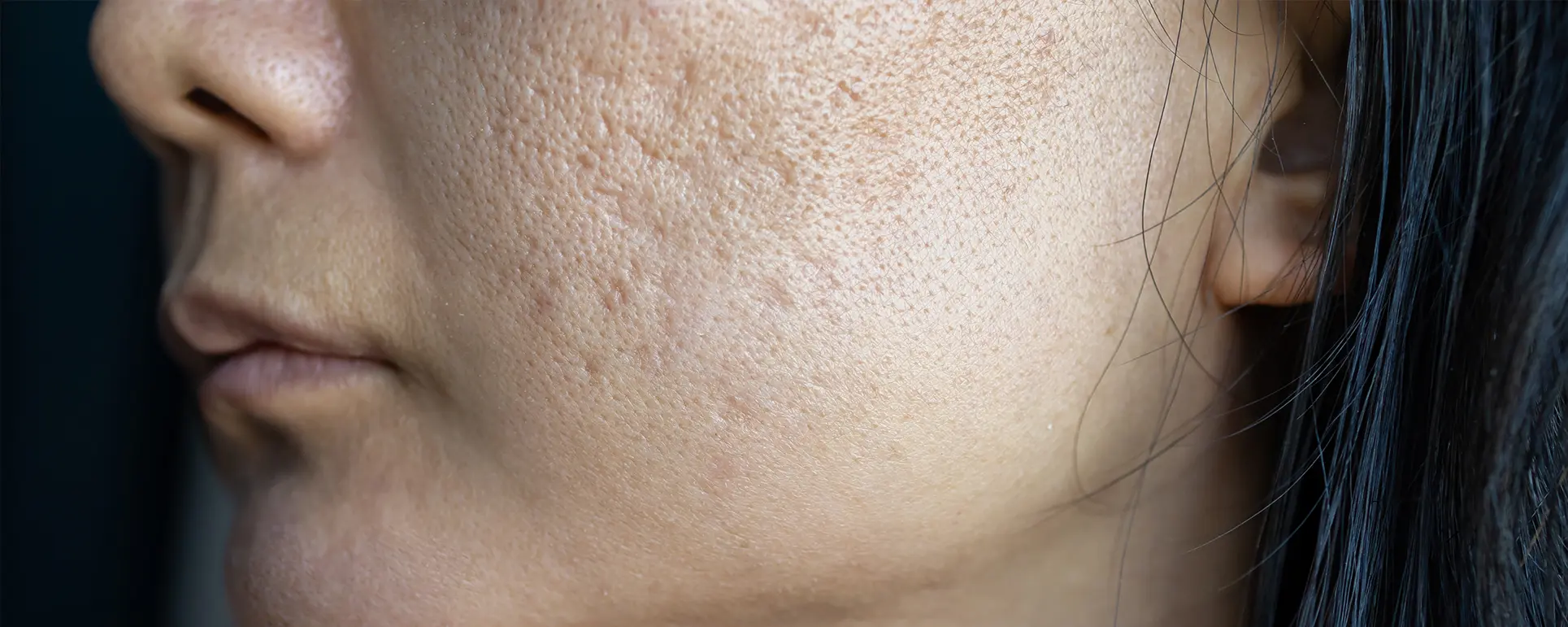If you’ve ever zoomed in on your skin in the mirror and wished your pores would disappear, you’re not alone. “How to shrink pores” is one of the most-searched skincare questions online and also one of the most misunderstood.
Countless products promise to “erase” or “close” pores overnight. But here’s the truth: you can’t physically make pores vanish. What you can do is make them look smaller, smoother, and healthier with the right approach.
In this article, we’ll unpack what actually causes large pores, debunk common myths, and highlight dermatologist-approved treatments that genuinely improve your skin’s texture based on science, not marketing.
What Are Pores, Exactly?
Pores are tiny openings on the surface of your skin that allow oil and sweat to reach the surface. They are essential for skin health acting like natural vents to keep your skin lubricated and temperature-regulated.
Each pore is connected to a sebaceous gland, which produces sebum (your skin’s natural oil). Sebum travels up through the pore and spreads across your skin, forming a protective barrier.
So rather than being “imperfections,” pores are part of how your skin stays balanced and functional.
Why Do Some Pores Look Larger Than Others?

The size and visibility of your pores depend on several factors many of which are beyond your control.
Here’s what influences pore size:
- Genetics: If your parents have visible pores, you’re likely to as well.
- Skin type: Oily skin tends to have larger-appearing pores due to more active sebaceous glands.
- Sun damage: UV exposure breaks down collagen and elastin, which support your pore walls, causing them to widen over time.
- Age: As you age, collagen loss and reduced skin elasticity make pores more noticeable.
- Hormones: Increased androgen levels can boost oil production, stretching pores.
- Clogging: Build-up of oil, dead skin, and debris can temporarily enlarge pores by stretching them.
Understanding these factors helps you choose treatments that target the real cause of your concern.
Myth 1: “You Can Close Your Pores”
Let’s clear this up right away pores don’t open and close like doors.
Pores have no muscles, so they can’t physically contract. What changes is how tight or loose the skin around them appears. When pores are filled with oil and dead cells, they look bigger. When they’re clear and supported by healthy collagen, they appear smaller and smoother.
So, while you can’t close pores, you can absolutely minimise their appearance through proper cleansing, exfoliation, and collagen-boosting treatments.
Myth 2: “Cold Water or Ice Shrinks Pores”
Rinsing your face with cold water may temporarily make pores look smaller but only because the surrounding skin tightens slightly. It doesn’t alter the actual pore structure.
Similarly, hot water or steam doesn’t “open” pores it only softens debris inside them, making extraction easier.
Myth 3: “Pore Strips Fix Everything”
Pore strips can remove surface blackheads and dead skin, but the effect is temporary. Overuse may even irritate the skin, causing redness or broken capillaries.
If you rely on them too often, you risk damaging your skin barrier leading to inflammation and more visible pores in the long term.
What Actually Works for Large Pores

Here’s the evidence-based truth: the most effective pore-refining treatments focus on oil control, exfoliation, and collagen stimulation.
Let’s look at the methods dermatologists actually recommend.
1. Cleansing the Right Way
Cleansing helps prevent pore blockage, but the type of cleanser matters.
- Use a gentle foaming cleanser with salicylic acid (a beta-hydroxy acid) to dissolve oil inside pores.
- Avoid harsh scrubs or alcohol-based products that strip your skin this can trigger rebound oil production.
- Double cleansing (oil-based cleanser followed by a water-based one) works well if you wear makeup or sunscreen daily.
Consistency is key: cleansing twice a day prevents debris build-up that stretches pores.
2. Regular Exfoliation
Exfoliating removes the layer of dead skin that can clog pores and dull your complexion.
- Chemical exfoliants like glycolic acid, lactic acid, or salicylic acid are ideal.
- Physical scrubs should be used sparingly to avoid micro-tears.
Using a mild chemical exfoliant 2–3 times per week helps pores stay clear and skin texture stay refined.
3. Retinoids (Vitamin A Derivatives)
Retinoids are gold-standard for improving pore size and texture. They speed up cell turnover, prevent clogs, and boost collagen.
Regular use of a topical retinoid (like tretinoin or adapalene) strengthens the pore lining and reduces oil flow.
However, retinoids can cause dryness at first start slowly and moisturise daily. Pregnant or breastfeeding women should avoid them and seek alternatives such as bakuchiol.
4. Niacinamide (Vitamin B3)
This powerhouse ingredient improves barrier function, regulates oil production, and reduces inflammation.
A 5–10% niacinamide serum used daily can make pores look smaller and skin tone more even over time.
It’s gentle enough for sensitive skin and pairs well with most other actives.
5. Professional Treatments That Work
When home skincare isn’t enough, in-clinic treatments can deliver more dramatic improvement.
Here’s what dermatologists often recommend:
Microneedling
Creates micro-injuries that stimulate collagen production and tighten the skin around pores.
Visible results after 3–4 sessions.
Laser Resurfacing (e.g., CO₂ or Fractional Laser)
Targets the deeper dermal layers to remodel collagen and improve texture.
Downtime varies from 3–7 days, but results are long-lasting.
Chemical Peels
Use controlled acids to exfoliate, unclog, and smooth skin.
Great for oily or acne-prone types.
Radiofrequency (RF) Microneedling
Combines microneedling with radiofrequency energy to enhance tightening and rejuvenation.
Excellent for enlarged pores and mild laxity.
If you’re considering professional options, it’s best to consult a Acne Clinic in London where a dermatologist can tailor your plan to your skin type, severity, and goals.
6. Laser Genesis or Nd:YAG Treatments
These gentle, non-ablative lasers heat the deeper skin layers to stimulate collagen without downtime. Over time, skin becomes firmer and pores appear less noticeable.
Perfect for maintenance after more intensive treatments.
7. Oil Regulation with Prescription Treatments
If excess oil is driving your pore size, prescription treatments such as topical retinoids or oral medications (e.g., low-dose isotretinoin) may help regulate sebum long-term.
These are used under strict medical supervision your dermatologist will assess if this approach is appropriate.
Daily Habits That Help Minimise Pore Appearance
Improving pore appearance isn’t just about treatments it’s about daily habits that support your skin health over time.
Here’s what to do (and what not to do):
Do:
- Cleanse twice a day with a gentle, non-drying cleanser.
- Use sunscreen daily UV damage weakens skin support around pores.
- Incorporate niacinamide and gentle acids in your routine.
- Stay hydrated and maintain a balanced diet.
Don’t:
- Sleep in makeup.
- Over-exfoliate it can inflame skin and enlarge pores.
- Pick at blackheads this stretches pore openings.
- Use thick, greasy products that clog pores.
Small, consistent actions have a big impact on how smooth your skin looks.
Lifestyle Factors That Influence Pore Size
Your skin doesn’t exist in isolation what you eat, how you manage stress, and even your sleep can influence your pores.
- Diet: High-glycaemic foods and dairy can trigger excess oil and inflammation in some people.
- Stress: Raises cortisol, which can increase oil production.
- Sleep: Lack of rest slows skin repair and collagen production.
- Smoking: Damages collagen and reduces blood flow, making pores look worse over time.
A holistic approach that includes both skincare and healthy habits produces the best results.
Pore Appearance by Skin Type
Different skin types show pores in unique ways.
If you have oily skin, your pores often appear larger and more visible, especially around the T-zone. Regular exfoliation, oil-control products, and ingredients like niacinamide can help minimise their appearance.
Those with combination skin usually notice enlarged pores around the nose and forehead. A balanced routine that uses gentle actives and lightweight moisturisers works best to manage both oily and dry areas.
People with dry skin tend to have smaller pores, but their skin may look dull or textured due to lack of moisture. Deep hydration and gentle resurfacing treatments can restore smoothness and radiance.
For mature skin, pores can appear more stretched or sagging due to collagen loss over time. Treatments such as retinoids, radiofrequency microneedling, or laser therapies can help firm the skin and refine its texture.
Customising your skincare based on your skin type ensures better results and fewer side effects.
What Doesn’t Work (and Might Make It Worse)
Some popular skincare trends may promise instant results but can actually aggravate your pores:
- DIY lemon juice masks: Too acidic can cause burns or pigmentation.
- Over-steaming: Breaks down the barrier and leads to dryness.
- Excessive scrubbing: Inflames skin and enlarges pores further.
- Alcohol-heavy toners: Strip oils and cause rebound oil production.
Stick with evidence-based treatments your skin will thank you.
How Ageing Affects Pores
As collagen and elastin decline with age, skin loses its “scaffolding.” This causes pores to sag and appear larger.
If you notice pores becoming more prominent in your 30s or 40s, focus on collagen-boosting treatments like microneedling, RF, or retinoids. Combining prevention (sun protection) with rejuvenation (laser or peels) delivers the best anti-ageing outcome.
Pores and Acne: The Connection
Enlarged pores and acne often go hand in hand because excess oil and dead skin cells clog hair follicles.
If your pores frequently get congested or inflamed, you may be dealing with comedonal or inflammatory acne.
At the Acne Clinic in London, dermatologists use personalised plans combining topical retinoids, antibiotics, or light-based therapies to treat both acne and pore visibility safely and effectively.
How Long Does It Take to See Results?
Improving pore appearance is a gradual process. Expect:
- 2–4 weeks: Smoother texture with consistent exfoliation.
- 6–8 weeks: Reduced oiliness and fewer blackheads.
- 3–6 months: Noticeable tightening and refinement after retinoid or professional treatments.
Patience and consistency are key quick fixes rarely last.
Skincare Routine for Pore-Prone Skin
Here’s a dermatologist-approved daily routine for clearer, refined-looking skin:
Morning:
- Gentle foaming cleanser.
- Niacinamide serum (5–10%).
- Lightweight, oil-free moisturiser.
- Broad-spectrum SPF 30–50.
Evening:
- Double cleanse if wearing makeup.
- Chemical exfoliant (2–3 nights/week).
- Retinoid (alternate nights).
- Barrier-repair cream with ceramides or hyaluronic acid.
Keeping it simple and consistent is more effective than layering multiple harsh actives.
When to See a Dermatologist
It’s time to book a professional consultation if:
- Your pores remain visibly enlarged despite good skincare.
- You experience frequent blackheads, breakouts, or acne scars.
- You have oily skin that feels congested no matter what you try.
- You want to explore in-clinic options like lasers or microneedling safely.
A dermatologist can assess whether your pore visibility is caused by genetics, oil imbalance, or ageing and design a targeted treatment plan for real, lasting improvement.
Frequently Asked Questions:
1. Can you permanently shrink your pores?
No, pores cannot be permanently shrunk because their size is largely determined by genetics and the structure of your skin. However, their appearance can be significantly minimised through consistent care and collagen-boosting treatments. Retinoids, chemical exfoliants like glycolic acid, and in-clinic procedures such as microneedling or laser resurfacing can make pores look smaller over time by keeping them clear and strengthening the surrounding skin.
2. Do pores get bigger as we age?
Yes, pores can appear larger with age. This happens as the skin loses collagen and elasticity, which weakens the walls around each pore, making them look stretched or sagging. Regular use of retinoids, sunscreen, and professional treatments like radiofrequency microneedling can help rebuild collagen, keeping the skin firm and pores less noticeable.
3. Does washing your face often help reduce pore size?
Washing your face twice a day with a gentle, non-stripping cleanser can help keep pores clear and prevent them from appearing enlarged. However, over-cleansing or using harsh products can irritate the skin and cause rebound oil production, which makes pores look even more prominent. The goal is balance clean, not stripped, skin.
4. Can diet really affect pore size?
Diet doesn’t directly change pore size, but certain foods can influence how active your oil glands are. Diets high in sugar or refined carbohydrates may trigger excess sebum production and inflammation, leading to clogged pores and breakouts. Maintaining a balanced diet rich in antioxidants, omega-3 fatty acids, and hydration supports clearer, smoother skin overall.
5. Is it possible to close pores with ice or cold water?
Cold water or ice can temporarily make pores look smaller because it causes mild constriction of the surrounding skin tissue. However, this effect is purely superficial and short-lived. Pores do not have muscles, so they cannot open or close. For lasting improvement, skincare ingredients that boost collagen or regulate oil such as retinoids, niacinamide, and gentle acids are far more effective.
6. Can sunscreen really help minimise pores?
Absolutely. Sun exposure damages collagen and elastin, which are essential for keeping pores tight and supported. Without this structural support, pores become more visible over time. Daily use of a broad-spectrum sunscreen with SPF 30 or higher protects the skin from UV damage, preserves collagen, and helps maintain smoother, more refined skin texture.
7. Why do pores look bigger after exfoliating?
Immediately after exfoliating, pores can sometimes appear more visible because the top layer of dead skin has been removed, making them momentarily clearer. However, this is temporary and actually a good sign it means your pores are unclogged. Over time, consistent exfoliation with gentle acids like salicylic or lactic acid will help refine skin texture and make pores appear smaller.
8. Do pore-minimising primers or makeup products work?
Pore-minimising primers and blurring makeup products can smooth the skin’s surface, creating the illusion of smaller pores. These are cosmetic fixes rather than long-term solutions. To genuinely improve pore visibility, combining such products with an effective skincare routine that includes exfoliants, niacinamide, and retinoids provides both instant and lasting results.
9. Are large pores the same as blackheads?
Not exactly. Large pores are simply dilated openings in the skin, while blackheads are clogged pores filled with oil and dead skin that oxidise when exposed to air. Although they often occur together especially in oily or acne-prone skin blackheads can be removed or treated, whereas pore size can only be improved, not eliminated. Regular cleansing and exfoliation help prevent blackhead formation and keep pores clear.
10. When should I see a dermatologist about large pores?
You should consider seeing a dermatologist if enlarged pores are affecting your confidence or if home skincare isn’t giving results after a few months. Persistent congestion, blackheads, or texture irregularities can indicate underlying issues such as acne or excess oil production. A dermatologist can assess your skin’s condition, rule out medical causes, and recommend targeted treatments like chemical peels, lasers, or prescription retinoids for the best outcome.
Final Thought: Achieving Smoother, Healthier Skin for the Long Term
While large pores can be a stubborn skin concern, understanding their real causes and managing them with science-backed treatments makes all the difference. Consistency is key no single product or quick fix can transform your skin overnight, but a targeted approach combining exfoliation, collagen stimulation, and sun protection can deliver visible, lasting results.
If your pores remain noticeable despite a good skincare routine, professional treatments such as microneedling, laser resurfacing, or radiofrequency can help refine and smooth your skin effectively. These advanced options not only improve texture but also boost overall skin health and radiance.
If you’re considering Acne Clinic in London, you can get in touch with us at London Dermatology Centre. Our dermatologists can design a personalised treatment plan to help you achieve clearer, smoother, and more confident skin.
References:
1. Lee, S.J., Seok, J., Jeong, S.Y., Park, K.Y. & Li, K., 2016. ‘Facial pores: definition, causes, and treatment options’, Dermatologic Surgery, 42(3), pp. 277-285. Available at: https://pubmed.ncbi.nlm.nih.gov/26918966/
2. Roh, M., Lee, W.J., Park, J.G. & Chung, J.H., 2006. ‘Sebum output as a factor contributing to the size of facial pores’, Dermatology, 212(4), pp. 316-320. Available at: https://pubmed.ncbi.nlm.nih.gov/17034515/
3. Shauly, O., 2023. ‘Radiofrequency microneedling: Technology, devices, and applications’, Journal of Cosmetic and Laser Therapy, [online]. Available at: https://pmc.ncbi.nlm.nih.gov/articles/PMC11181949/
4. Flament, F., et al., 2015. ‘Facial skin pores: a multi-ethnic study’, International Journal of Dermatology, [online]. Available at: https://pmc.ncbi.nlm.nih.gov/articles/PMC4337418/
5. Vitale, M., et al., 2024. ‘Efficacy, tolerability, and face lipidomic modification of a topical formulation: Pores reduction and improved texture’, Applied Sciences, 14(17), 7799. Available at: https://www.mdpi.com/2076-3417/14/17/7799
